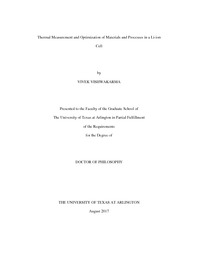
ATTENTION: The works hosted here are being migrated to a new repository that will consolidate resources, improve discoverability, and better show UTA's research impact on the global community. We will update authors as the migration progresses. Please see MavMatrix for more information.
Show simple item record
| dc.contributor.advisor | Jain, Ankur | |
| dc.creator | Vishwakarma, Vivek | |
| dc.date.accessioned | 2017-10-02T14:03:57Z | |
| dc.date.available | 2017-10-02T14:03:57Z | |
| dc.date.created | 2017-08 | |
| dc.date.issued | 2017-08-02 | |
| dc.date.submitted | August 2017 | |
| dc.identifier.uri | http://hdl.handle.net/10106/26958 | |
| dc.description.abstract | Applications of Lithium-ion cells range from consumer electronics to electric cars because of their excellent electrochemical performance and energy density. However, a Li-ion cell also suffers from poor thermal transport characteristics, which reduces performance, causes overheating and thermal runaway. This work contributes towards thermal characterization of key Li-ion battery materials and identifies and improves the rate-limiting, material-level thermal conduction process in a Li-ion cell.
Among the various materials within a Li-ion cell, the separator is expected to have the lowest thermal conductivity. In this work, we have carried out first-ever measurements of thermal conductivity and heat capacity of the separator material. These measurements are based on thermal response to an imposed DC heating within a time period during which an assumption of a thermally semi-infinite domain is valid. This in-plane measurement technique required microfabrication of microheater and thermal sensor on the flexible separator material. Experimental data are found to be in excellent agreement with the analytical model. Further investigation of heat transfer in Li-ion battery at material level resulted in the identification of cathode-separator interfacial heat transfer as the rate-limiting process that dominates overall thermal conduction in a Li-ion cell. This interfacial contact resistance contributes about 88% of the total thermal resistance in the cell. Further, to address this problem, an amine-based chemical bridging of the interface has been carried out. Experiments have shown that chemical bridging between separator and electrode resulted in significant reduction in the interfacial thermal resistance without any deterioration in electrochemical performance.
While conventional Li-ion cells utilize liquid electrolytes, future Li-ion cells are expected to use gel polymer electrolytes (GPEs) due to improved performance, safety and the possibility of a wide variety of shapes, sizes, and dimensions. Thermal properties of polymer electrolyte such as thermal conductivity and heat capacity are important parameters that will govern the thermal performance of future polymer Li-ion cells. In this work, we present the measurements of thermal and ionic conductivities in a PVdF-based GPE. The effect of incorporating BN/Al2O3 ceramic nano/microparticles in the GPE on thermal and ionic transport has been also characterized. The fundamental insights gained in this work on thermal transport in a GPE and the role of nano/microparticle inclusions may facilitate thermal-electrochemical optimization and design of GPEs for safe, high-performance Li-ion cells. | |
| dc.format.mimetype | application/pdf | |
| dc.language.iso | en_US | |
| dc.subject | Lithium-ion cells | |
| dc.subject | Separator | |
| dc.subject | Thermal | |
| dc.subject | Conductivity | |
| dc.subject | Heat capacity | |
| dc.subject | Battery safety | |
| dc.subject | Flexible substrate | |
| dc.subject | Thermal management | |
| dc.subject | Heat transfer | |
| dc.subject | Interfacial thermal conductance | |
| dc.subject | Thermal runaway | |
| dc.subject | Gel polymer electrolyte | |
| dc.subject | Nanoparticles | |
| dc.subject | Thermal transport | |
| dc.subject | Battery safety | |
| dc.title | Thermal Measurement and Optimization of Materials and Processes in a Li-ion Cell | |
| dc.type | Thesis | |
| dc.degree.department | Mechanical and Aerospace Engineering | |
| dc.degree.name | Doctor of Philosophy in Mechanical Engineering | |
| dc.date.updated | 2017-10-02T14:03:58Z | |
| thesis.degree.department | Mechanical and Aerospace Engineering | |
| thesis.degree.grantor | The University of Texas at Arlington | |
| thesis.degree.level | Doctoral | |
| thesis.degree.name | Doctor of Philosophy in Mechanical Engineering | |
| dc.type.material | text | |
Files in this item
- Name:
- VISHWAKARMA-DISSERTATION-2017.pdf
- Size:
- 3.698Mb
- Format:
- PDF
This item appears in the following Collection(s)
Show simple item record


